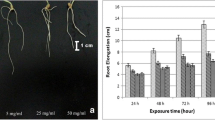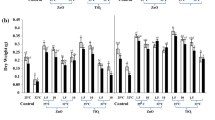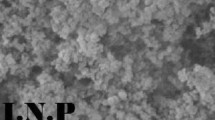Abstract
The development of nanotechnologies has increased the amount of manufactured metal oxide nanoparticles in the environment. In the view of nanoparticle dispersion to the environment, assessment of their toxicity becomes very crucial. Aluminum oxide (Al2O3) nanoparticles have wide range of use in industry as well as personal care products. The aim of this study was to evaluate the dose dependent effects of 13-nm-sized Al2O3 nanoparticles on wheat correlating with the appearance of enzymatic and non-enzymatic antioxidant defense response. Wheat roots were exposed to different concentrations of Al2O3 nanoparticles (5, 25 and 50 mg mL−1) for 96 h. The effects of Al2O3 nanoparticles were studied using different parameters such as H2O2 content, superoxide dismutase and catalase activity, lipid peroxidation, total proline, photosynthetic pigment and anthocyanin content. The results indicated that while Al2O3 nanoparticles caused a dose dependent increase in H2O2 content, superoxide dismutase activity, lipid peroxidation and proline contents, the catalase activity was decreased in compare the control. Moreover, total chlorophyll, chlorophyll a, carotenoids and anthocyanin contents reduced in the highest concentration 50 mg mL−1. In conclusion, Al2O3 nanoparticles caused oxidative stress in wheat after 96 h.






Similar content being viewed by others
References
Arnon DI (1949) Copper enzymes in isolated chloroplasts, polyphenoxidase in Beta vulgaris. Plant Physiol 24:1–15
Bates LS (1973) Rapid determination of free proline for water-stress studies. Plant Soil 39:205–207
Burklew CE, Ashlock J, Winfrey WB, Zhang B (2012) Effects of aluminum oxide nanoparticles on the growth, development, and microRNA expression of tobacco (Nicotiana tabacum). PLoS One 7(5):e34783
Cakmak I, Horst JH (1991) Effects of aluminum on lipid peroxidation, superoxide dismutase, catalase, and peroxidase activities in root tips of soybean (Glycine max). Physiol Plant 83:463–468
Cakmak I, Marschner H (1992) Magnesium deficiency and high light ıntensity enhance activities of superoxide dismutase, ascorbate peroxidase, and glutathione reductase in bean leaves. Plant Physiol 98:1222–1227
Chen C, Dickman MB (2005) Proline suppresses apoptosis in the fungal pathogen Colletotrichum trifolii. PNAS 102:3459–3464
Chen Z, Silva H, Klessig DF (1993) Active oxygen species in the induction of plant systemic acquired resistance by salicylic acid. Science 262:1883–1886
Cho YW, Park EH, Lim CJ (2000) Glutathione S-transferase activities of S-type and L-type thiol transferase from Arabidopsis thaliana. J Biochem Mol Biol 33:179–183
Cornelis G, Kerstin HR, Kuhlbusch T, Brink NVD, Nickel C (2014) Fate and bioavailability of engineered nanoparticles in soils: a review. Crit Rev Environ Sci Technol 44:2720–2764
Dat JF, Foyer CH, Scott IM (1998) Changes in salicylic acid and antioxidants during induced thermotolerance in mustard seedlings. Plant Physiol 118:1455–1461
Foyer CH, Noctor G (2005) Redox homeostis and antioxidant signaling: a metabolic interface between stress perception and physiological responses. Plant Cell 17:1866–1875
Gill SS, Tuteja N (2010) Reactive oxygen species and antioxidant machinery in abiotic stres tolerance in crop plants. Plant Physiol Biochem 48:909–930
Hanemann T, Szabó DV (2010) Polymer-nanoparticle composites: from synthesis to modern applications. Materials 3:3468–3517
Junglee S, Urban L, Sallanon H, Lopez-Lauri F (2014) Optimized assay for hydrogen peroxide determination in plant tissue using potassium iodide. Am J Anal Chem 5:730–736
Keller AA, Wang H, Zhou D, Lenihan HS, Cherr G, Cardinale BJ, Miller R, Ji Z (2010) Stability and aggregation of metal oxide nanoparticles in natural aqueous matrices. Environ Sci Technol 44:1962–1967
Ma C, Chhikara S, Xing B, Musante C, White JC, Dhankher OP (2013) Physiological and molecular response of Arabidopsis thaliana (L.) to nanoparticle cerium and indium oxide exposure. ACS Sustain Chem Eng 1:768–778
Ma C, White JC, Dhankher OP, Xing B (2015) Metal-based nanotoxicity and detoxification pathways in higher plants. Environ Sci Technol 49:7109–7122
Mehdy MC (1994) Active oxygen species in plant defense against pathogens. Plant Physiol 105:467–472
Miralles P, Church TL, Harris AT (2012) Toxicity, uptake, and translocation of engineered nanomaterials in vascular plants. Environ Sci Technol 46:9224–9239
Mishra NP, Mishra NK, Singhal GS (1995) Changes in the activities of anti-oxidant enzymes during exposure of intact wheat leaves to strong visual light at different temperatures in the presence of protein synthesis inhibitors. Plant Physiol 102:903–910
Mittler R (2002) Oxidative stress, antioxidants and stress tolerance. Trends Plant Sci 7:405–410
Montillet JL, Chamnongpol S, Rustérucci C, Dat J, van de Cotte B, Agnel JP, Battesti C, Inzé D, Van Breusegem F, Triantaphylides C (2005) Fatty acid hydroperoxides and H2O2 in the execution of hypersensitive cell death in tobacco leaves. Plant Physiol 138:1516–1526
Nair PMG, Chung IM (2014a) Impact of copper oxide nanoparticles exposure on Arabidopsis thaliana growth, root system development, root lignificaion, and molecular level changes. Environ Sci Pollut Res 21:12709–12722
Nair PMG, Chung IM (2014b) Physiological and molecular level effects of silver nanoparticles exposure in rice (Oryza sativa L.) seedlings. Chemosphere 112:105–113
Nair PMG, Kim SH, Chung IM (2014) Copper oxide nanoparticle toxicity in mung bean (Vigna radiata L.) seedlings: physiological and molecular level responses of in vitro grown plants. Acta Physiol Plant 36:2947–2958
Navarro E, Baun A, Behra R, Hartmann NB, Filser J, Miao AJ (2008) Environmental behavior and ecotoxicity of engineered nanoparticles to algae, plants, and fungi. Ecotoxicology 17:372–386
Nel A, Xia T, Li N (2006) Toxic potential of materials at the nano levels. Science 311:622–627
Quan LJ, Zhang B, Shi WW, Li HY (2008) Hydrogen peroxide in plants: a versatile molecule of the reactive oxygen species network. J Integr Plant Biol 50:2–18
Rabino I, Mancinelli AL (1986) Light, temperature and anthocyanin production. Plant Physiol 81:922–924
Riahi-Madvar A, Rezaee F, Jalali V (2012) Effects of alumina nanoparticles on morphological properties and antioxidant system of Triticum aestivum. Iran J Plant Physiol 3:595–603
Rico CM, Morales MI, McCreary R (2013) Cerium oxide nanoparticles modify the antioxidative stress enzyme activities and macromolecule composition in rice seedlings. Environ Sci Technol 47:14110–14118
Shim IS, Momose Y, Yamamoto A, Kim DW, Usui K (2003) Inhibition of catalase activity by oxidative stress and its relationship to salicylic acid accumulation in plants. Plant Growth Regul 39:285–292
Shirazi AM, Shariati F, Keshavarz AK, Ramezanpour Z (2015) Toxic effect of aluminum oxide nanoparticles on green micro–algae Dunaliella salina. Int J Environ Res 9:585–594
Wu SB, Wu YT, Wu TP, Wei YH (2014) Role of AMPK–mediated adaptive responses in human cells with mitochondrial dysfunction to oxidative stress. Biochim Biophys Acta 1840:1331–1344
Yanık F, Vardar F (2015) Toxic effects of aluminum oxide (Al2O3) nanoparticles on root growth and development in Triticum aestivum. Water Air Soil Pollut 226:296
Acknowledgments
This study is supported by Research Foundation of Marmara University (BAPKO) project number FEN-A-110915-0431.
Author information
Authors and Affiliations
Corresponding author
Rights and permissions
About this article
Cite this article
Yanık, F., Vardar, F. Oxidative stress response to aluminum oxide (Al2O3) nanoparticles in Triticum aestivum. Biologia 73, 129–135 (2018). https://doi.org/10.2478/s11756-018-0016-7
Received:
Accepted:
Published:
Issue Date:
DOI: https://doi.org/10.2478/s11756-018-0016-7




